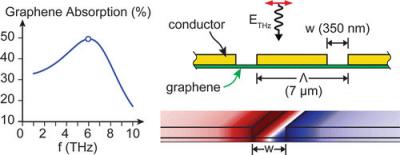A collaborative team of researchers from the University of Maryland (UMD), Monash University and the United States Naval Research Laboratory has designed a Tunable Large Area Hybrid Metal-Graphene Terahertz Detector, an innovation based upon a successful demonstration of plasmonic resonance in graphene micro-ribbons that are connected to metal electrodes. This work may be a significant step toward practical graphene terahertz optoelectronic devices.

Graphene is interesting for terahertz range applications (the part of electromagnetic spectrum between microwaves and infrared light) because the free electrons in the material oscillate collectively at these frequencies. The resonance frequency can be tuned by applying an electric voltage at the gate. Being able to tune the resonance frequency allows the resonator to be adjusted, making it usable in a broad range of applications, both scientific and commercial.
Until now, however, graphene-based terahertz sensors have mostly been theoretical because graphene must touch a metal surface to read out the results or tune the sensor, and this was previously thought to inhibit the plasmonic resonance. For this reason, the team invented a new design that does not inhibit charge accumulation at the contact and allows the signal to transfer from the graphene to the metal electrical contacts much more effectively.
In fact, electrical connection or antenna coupling to graphene is a problem that has intrigued researchers for many years; The discovery has the potential to advance the field, and the team is excited to continue their research and further develop the technology in preparation for commercialization. According to the researchers perhaps the most promising short-term application would be for room-temperature tunable terahertz detectors".
In October 2015, An international team of scientists from Helmholtz-Zentrum Dresden-Rossendorf (HZDR), the University of Maryland and more, have developed a graphene-based optical detector which reacts very rapidly to incident light of all different wavelengths and works at room temperature. In April 2016, Scientists at the Swiss EPFL and the University of Geneva developed a microchip that filters out unwanted radiation. The device, called an optical isolator, works in the terahertz gap.